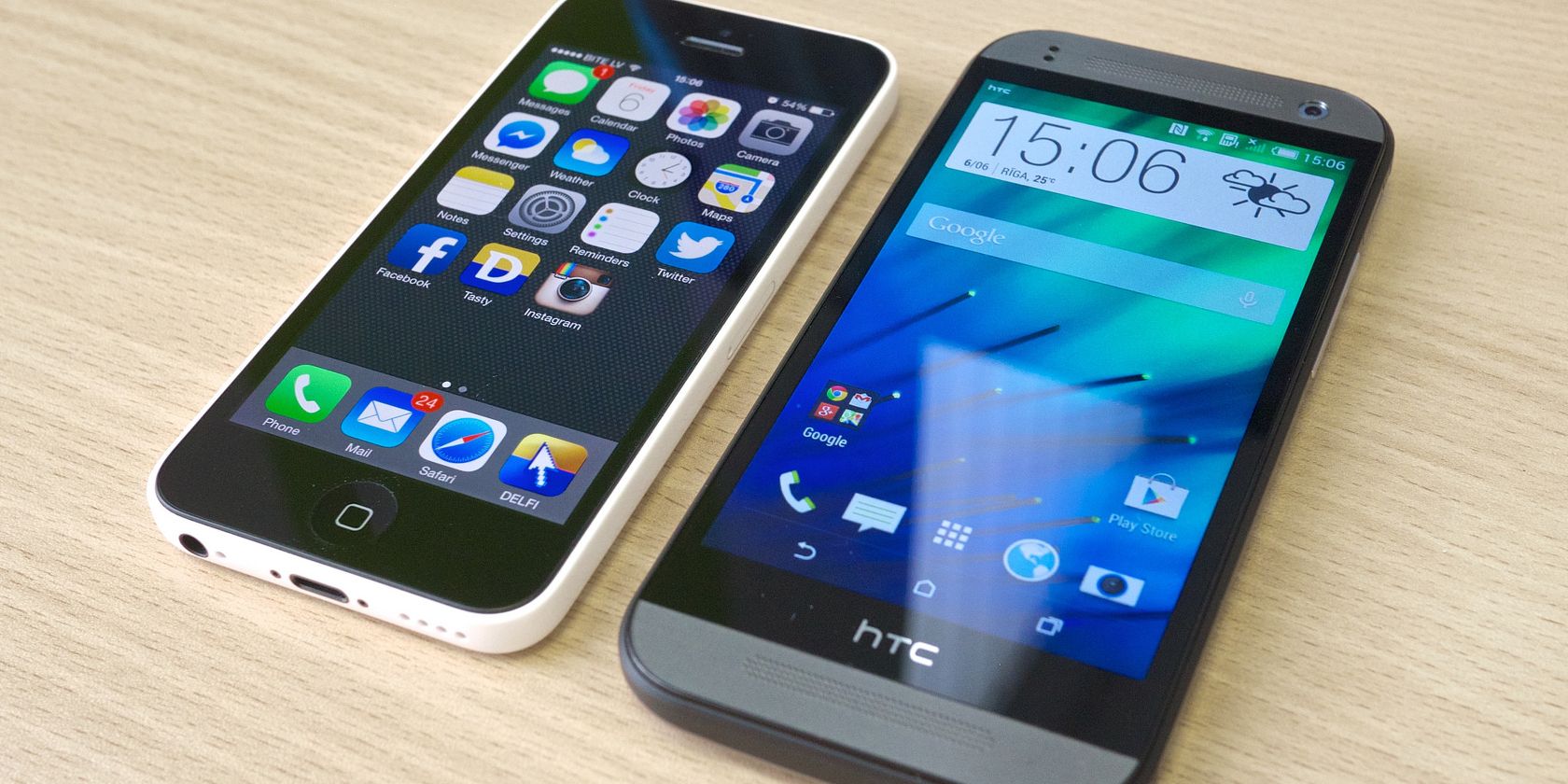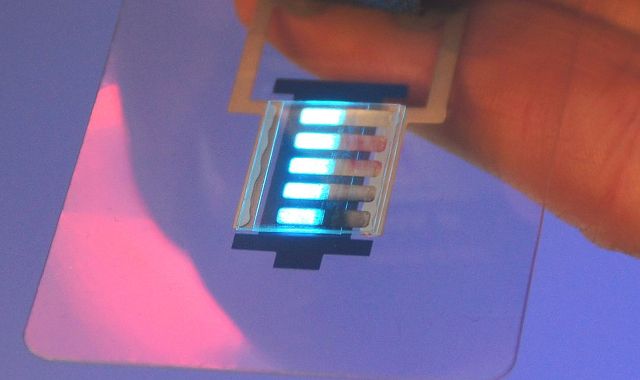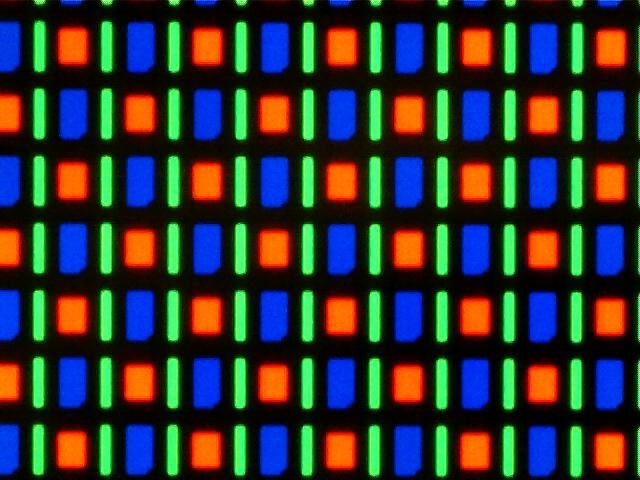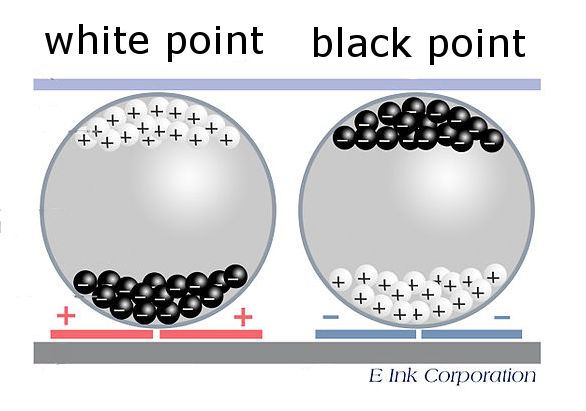When you're comparing different mobile devices, whether they're phones, tablets, e-readers, or laptops, one of the differentiating features can be the display technology. But do you know the difference between OLED and AMOLED? What about LCD and e-ink? This guide will get you up to speed.
Liquid Crystal Display (LCD) and Retina
Liquid crystal is a fascinating substance that has molecular properties of both liquids and solids -- the application of an electrical current affects those properties, allowing more or less light to pass through a particular pixel, creating a gray scale.
In a full-color display, each pixel has three sub-pixels: one with a red filter, one with green, and one with blue. To create colors, different levels of light are passed through each sub-pixel. If you look really closely at an LCD screen, you can often pick out the sub-pixels, as in this image:
Apple's Retina technology is a specific type of LCD called an in-place switching (IPS) LCD. This technology offers wider viewing angles and lower power consumption. The Retina label is applied when the pixel density is higher than can be distinguished by the human eye.
Obviously, to create light behind the color filters of an LCD screen, a backlight is needed. This is usually created using small fluorescent tubes and a reflector that scatters the light evenly through the pixels on the screen. Because of the large backlights in LCDs, blacks tend to be relatively bright, making for less contrast. LCDs also use more power than LED-based screens, are more affected by viewing angle, and occasionally suffer from dead pixels (though dead pixels can be fixed).
However, LCD production cost is still notably lower than many other options, meaning it's easier to get a high-quality screen without breaking the bank. And even though it's been around for a long time, you can still get really great screens, like those included in the iPhone 5, iPad Air, and Nexus 5.
Organic Light-Emitting Diode (OLED)
LEDs are tiny devices that emit light of a single color, determined by the material used to create the diode. In traditional LEDs, metals like aluminum gallium arsenide (red), aluminum gallium indium phosphide (green), and zinc selenide (blue) are used.
There are a number of advantages to LEDs: they use less power than LCDs, they're smaller and lighter, and each pixel is individually lit, making for much deeper blacks than a back-lit LCD.
Traditional LEDs, however, are too large to be used to create small displays; they may be used on the mega-screens you see in stadiums and in digital advertising, but you won't see them in your cell phone display.
OLEDS, unlike LEDs, use carbon-based substances to create light instead of base metals. The molecular difference isn't what's important here, though -- the advantage of OLEDs over LEDs is that they're significantly smaller, meaning they can be used to create mobile displays at high resolutions. They're so small, in fact, that they can actually be applied to materials by an inkjet printer or screen printing.
Because each pixel is individually lit, and there's no large backlight, OLEDs offer significantly better blacks than LCD screens, and they're also superior in terms of power consumption. Their very small size make them lighter, as well.
However, OLEDs are generally quite expensive in comparison to LCDs, and blue diodes tend to degrade faster than other colors, leaving OLED screens with color-balance issues after many hours of use.
You can find an OLED screen on the LG G Flex and the Samsung Galaxy Round [Broken URL Removed].
Active-Matrix OLED (AMOLED)
While OLEDs are more power-efficient than LCD screens, manufacturers of mobile devices are always looking for ways to increase the battery life of their devices, and adding an active matrix to OLED technology is one of the ways they can do this.
An active matrix is a thin-film transistor that's integrated with the OLED matrix. This might sound complicated and technical, but the takeaway is simple: the circuitry for lighting the LEDs is more closely integrated with the LEDs themselves, reducing the amount of power that's needed to operate the display. This leads to better battery life in your device. They also have faster refresh rates (what is a refresh rate?), making them good for watching video.
Many Samsung products, including the Galaxy S5, sport Super AMOLED screens, which integrate the touchscreen technology into the AMOLED display, allowing for an even thinner and lighter screen.
E-Ink
If you've ever used a Kindle, Nook, or Kobo, you've seen e-ink. The distinctive grayscale look stands out in a market saturated with bright display technologies.
E-ink works by applying an electric charge to hundreds of thousands of tiny cells on a page—the charge causes tiny pigmented chips to rise to the surface or fall away from it, and by applying the correct charges throughout the page, patterns can be created, forming text on the page.
There a number of significant advantages to e-ink displays: they're very easy on the eyes, as they lack a harsh backlight; they're easily readable in direct sunlight, just like paper; and they're very energy efficient, as they only draw power when the display is being updated (this is why your Kindle lasts so long on a single charge).
At the moment, grayscale e-ink is the norm, but a number of companies are racing to bring a color e-ink screen to major market release.
While e-readers are the primary beneficiaries of e-ink technology, a couple phones have used it, like the Motorola F3 and the Samsung Alias 2. You'll also see them on small devices like keyfobs that display access codes, and even on a Lexar USB stick.
Future Display Technologies
Display technology is advancing, and we're likely to benefit from new tech in the near future. I mentioned the fact that OLEDs can be used to create flexible displays, and this has been on display at the E3 convention in recent years. Don't be surprised if your next cell phone has a semi-flexible screen.
Another interesting application of OLEDs is the transparent OLED (TOLED) technology that powers the Samsung Smart Window (below) and this transparent laptop from 2010.
Quantum-dot LEDs are an interesting technology that looks to have a lot of potential, as well—they're pitched by NanoSys as a way for LCD manufacturers to compete with OLEDs. A quantum dot is a "light-emitting semiconductor nanocrystal" that is very bright, long-lasting, and allows for a huge range of colors.
And, of course, we'll all be looking forward to full-color e-ink. Kyobo's Mirasol e-reader had the technology, but was discontinued shortly after launch due to stiff competition and low demand. The Hanvon C18 is one of the current models, though it's hard to get hold of outside of China.
While it's difficult to predict what we'll see next, it's safe to say that stronger, lighter, brighter, and more flexible displays are on the way. What kind of display are you using at the moment? Are you looking to switch to another type? What are you most excited to see coming up? Share your thoughts below!
Image credits: K?rlis Dambr?ns via Flickr, Mattia Luigi Nappi, Matthew Rollings, Libranova via Wikimedia Commons.





